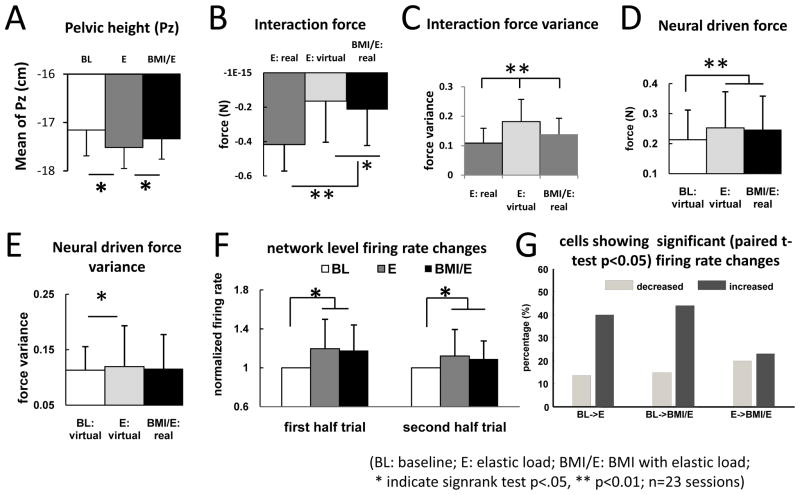Figure 3.
Changes of force and variance of pelvic motion (Py) and mean neural firing rates across all rats and sessions. A. The rats in simple elastic load (E) showed a significantly depressed pelvic mean position, compared to Baseline (BL), while BMI with elastic load (BMI/E) showed a height that was not significantly different from baseline but significantly different from E. The rats in BMI normalized pelvic height. B. Mean interaction force loading in E was significantly greater than in BMI/E (real) and also greater than the calculated E virtual. C. Interaction force variance in E:virtual was greater than either BMI/E(real) or E (real). D. Mean neural driven force in BMI matched E:virtual neural driven force. Both were significantly larger than baseline (BL:virtual) neural driven force. E. E:virtual neural driven force variance was significantly greater than Baseline virtual force (BL:virtual) but not BMI (BMI:real) F. Mean neural firing rates normalized to baseline in both the first half trial and second half trial differed significantly in E and BMI/E compared to BL, consistent with panel D (Neural Driven Forces). Both were slightly but not significantly reduced in the second half trial compared to the first. Differences were tested by signed rank test in A to F (* indicates p<0.05; ** indicates p<0.01;). G. Individual cell significant rate changes obtained with paired t-tests showed high percentages of cells with significant rate increases (>40%) compared to decreases (>20%) from BL to E and BL to BMI/E, but ~25% increase and 25% decrease in comparisons from E to BMI/E. The mean and variance of the interaction forces and neural driven forces in step cycle across all sessions and rats showed similar patterns of variation and statistics as in the single trial in Figure 2 (Fig. 2D–G), except that the variance of the neural driven force also showed some differences. Neural rates showed changes consistent with these effects. Rats in BMI normalized their pelvic height kinematics, but at the same time increased neural firing rates and reduced interaction force loads, thus differing from both simple elastic load and baseline in various ways.

